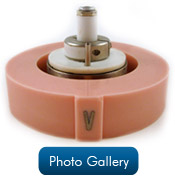Asphalt Binder Cracking Device
Technical Specifications
The ABCD system is shipped with the following components:
- An environmental chamber capable of cooling a specimen at a constant rate to temperatures of -60ºC.
- A computer and data acquisition system, which records real-time strain and temperature readings.
- Specimen silicone molds, which are used to prepare and hold the asphalt binder specimens for testing.
- The ABCD rings, to be placed inside of the specimen mold and provide restraint as the asphalt binder contracts during the cooling process.
- Testing accessories: temperature controlled pouring device and turntables to aid trimming.
How it works:
After the binder samples are prepared, they are placed in a small environmental chamber that cools the samples at a pre-determined rate. At least three samples of the same specimen are recommended for each test. During the cooling and data recording process, the computer program does all of the test work. The program records the strain and temperature readings at ten-second intervals. A real-time plot of the binder strain and temperature is recorded in the data acquisition software and the test is ended when the samples crack. The cracking temperature is recorded as the temperature where a sudden strain jump appears on the strain versus temperature plot. The strength of the asphalt binder can also be determined from the magnitude of the strain jump. Again, only the ABCD can accurately and simultaneously measure the thermal stress and cracking temperature of asphalt binders.

